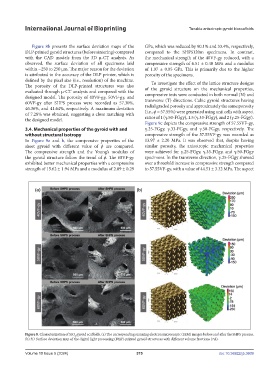Page 383 - IJB-10-5
P. 383
International Journal of Bioprinting Tunable anisotropic gyroid bioscaffolds
Figure 8b presents the surface deviation maps of the GPa, which was reduced by 90.1% and 33.4%, respectively,
DLP-printed gyroid structures (before sintering) compared compared to the SHPS120m specimens. In contrast,
with the CAD models from the 3D µ-CT analysis. As the mechanical strength of the 40VF-gy reduced, with a
observed, the surface deviation of all specimens laid compressive strength of 6.51 ± 0.40 MPa and a modulus
within −250 to 250 µm. The major reason for the deviation of 1.07 ± 0.05 GPa. This is primarily due to the higher
is attributed to the accuracy of the DLP printer, which is porosity of the specimens.
defined by the pixel size (i.e., resolution) of the machine. To investigate the effect of the lattice structure designs
The porosity of the DLP-printed structures was also of the gyroid structure on the mechanical properties,
evaluated through µ-CT analysis and compared with the compressive tests were conducted in both normal (N) and
designed model. The porosity of 40VF-gy, 50VF-gy, and transverse (T) directions. Cubic gyroid structures having
60VF-gy after SHPS process were recorded as 57.30%, radial graded porosity and approximately the same porosity
46.36%, and 41.64%, respectively. A maximum deviation
of 7.28% was obtained, suggesting a close matching with (i.e., ϕ = 57.55%) were generated using unit cells with aspect
the designed model. ratios of 1 (γ.50-FGgy), 1.5 (γ.33-FGgy), and 2 (γ.25-FGgy).
Figure 9c depicts the compressive strength of 57.55VF-gy,
3.4. Mechanical properties of the gyroid with and γ.25-FGgy, γ.33-FGgy, and γ.50-FGgy, respectively. The
without structural isotropy compressive strength of the 57.55VF-gy was recorded as
In Figure 9a and b, the compressive properties of the 13.97 ± 2.20 MPa. It was observed that, despite having
sheet gyroid with different value of ϕ are compared. similar porosity, the anisotropic mechanical properties
The compressive strength and the Young’s modulus of were achieved for γ.25-FGgy, γ.33-FGgy, and γ.50-FGgy
the gyroid structure follow the trend of ϕ. The 60VF-gy specimens. In the transverse direction, γ.25-FGgy showed
exhibited better mechanical properties with a compressive over a threefold increase in compressive strength compared
strength of 15.62 ± 1.94 MPa and a modulus of 2.09 ± 0.29 to 57.55VF-gy, with a value of 44.51 ± 3.32 MPa. The aspect
Figure 8. Characterization of SiO gyroid scaffolds. (a) The corresponding scanning electron microscopic (SEM) images before and after the SHPS process.
2
(b) 3D Surface deviation map of the digital light processing (DLP)-printed gyroid structures with different volume fractions (≠ϕ).
Volume 10 Issue 5 (2024) 375 doi: 10.36922/ijb.3609

